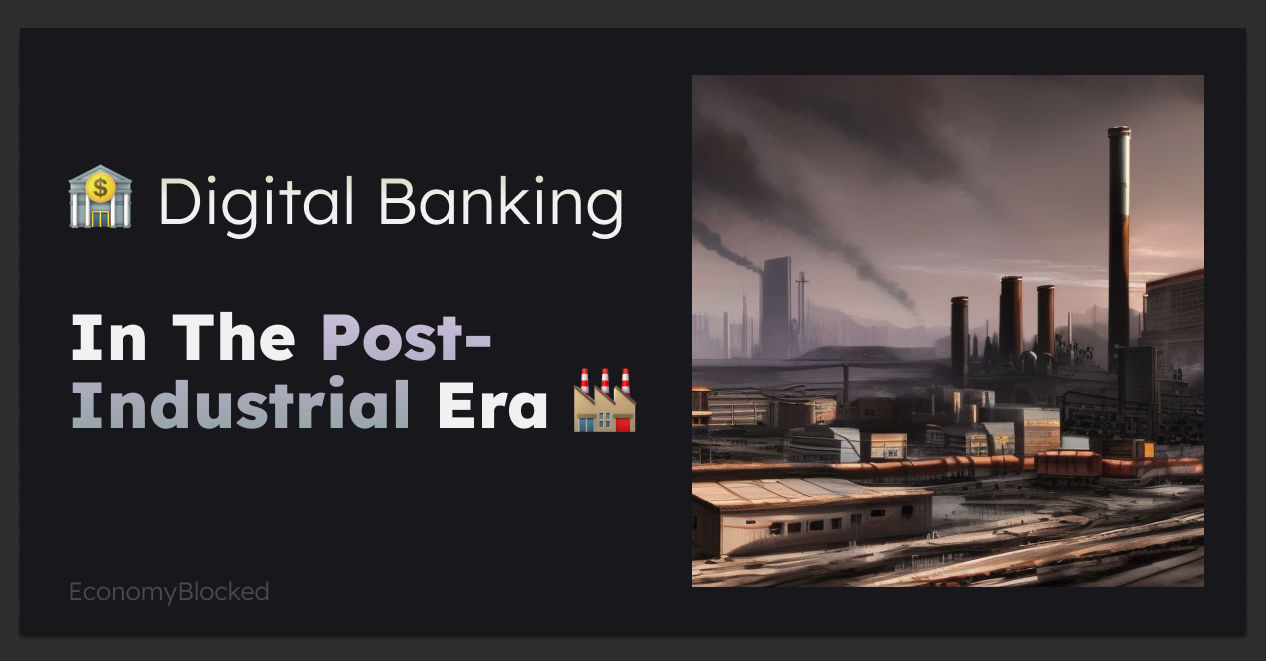🏦 Introduction
Greetings, fam! I am writing to you from Southern California, where we have been receiving heavy rain for the past few days. Although the rain has abated, more rain is expected within the next few weeks…. In this week’s EconomyBlocked main event, we will discuss digital banking in the post-industrial era.
To begin, I will explain what digital banking is, followed by an overview of each deployment method. We will review the catalyst to forced adoption brought on by COVID-19 for digital banking, digital banking market research and regional penetration rates, and business opportunities. In order to validate this paradigm shift for society and industry, we will also examine some of the mechanisms surrounding the transition to a post-industrial economy.

🧩 Table Of Content:
📲 Mobile-First & 🏦 Digital Banking | What is Digital-Banking?
What is Digital Banking? The term digital banking refers to the use of technology to access financial services as a sub-segment of financial technology (fintech), including checking accounts, transferring money, or paying bills. Various modes of accessing these services can be used, including mobile phones, tablets, computers, and internet-connected devices. Essentially, it represents the digitization of traditional banking services and includes neo-banks, banks that operate completely online and do not have physical branches.
The popularity of this method of banking is increasing due to the ease and speed with which financial transactions can be completed, as well as the convenience and security they can offer. The 2008 subprime and collateralized debt obligation crisis rocked the world economy to its core and threatened a full collapse of the financial system, leading to distrust in legacy banking which led to the rise in alternative banking institutions as a way to make up for this deficit.
🏛️ The Components of a Digital Bank
A digital bank has two primary components if we zoom out and examine the mechanics of the business structure. End users interact with the front-end services(user interface), and bankers, analysts, etc use the back-end services and admin panels to manage the services.
Digital banking is characterized by how the bank manages the servers that host its services - There are two distinct deployment methods for digital banks: on-premises or cloud-based. A bank’s IT department manages both hardware and software in an on-premise deployment. This method is used by banks with their own data centers with full autonomy over their infrastructure. Due to the upfront investment required, on-premise deployments are substantially more expensive than cloud deployments.
☁️ Cloud vs 🧱 On-premisE digital banking deployments
A cloud-based deployment refers to the bank’s IT department using a third-party cloud provider, such as AWS, Azure, Google Cloud, or Oracle Cloud, to manage its infrastructure. Banks that want to optimize their core service offerings instead of managing infrastructure, such as servers, use this method. The third type of digital bank is the hybrid cloud, which combines on-premise and cloud-based deployment methods.
In digital-first banking, communication between banks is enabled through APIs or Application Programming Interfaces. Banks can share resources and consume data from one another to improve the user experience (CX) and offer more targeted services based on location, demographics, and other identifiers.
Since the Internet was introduced in the 1990s, digitalization in banking has continued to grow as more banks migrate online or redesign their legacy systems for the Internet. The banking and finance industries were among the first to utilize technology for strategic purposes.
As the shift from brick-and-mortar banking to digital and mobile-first continues, we will see more and more consumers adopting digital-first banking solutions, as traditional banking and financial Institutions with legacy businesses port their services online.

☣️ A Catalyst To Digital-Banking Forced Adoption ⚔️
As a result of the subprime and CDO financial crisis of 2008, alternative banking and Fintech services, digital currencies, and blockchain emerged. Satoshi Nakamoto released the Bitcoin whitepaper (BTC) in 2008, outlining the guidelines for the first viable cryptographic digital currency. The COVID-19 pandemic prompted the universal acceptance of digital banking and accelerated the adoption of cryptocurrencies.
The pandemic resulted in the activation and retention of many baby boomers and older demographics, who possess greater cumulative wealth than the younger demographics.
Further transformation within the digital banking industry is influenced by de-globalization, geopolitical pressures, and macroeconomic trends. Since Adam Smith published The Wealth Of Nations in 1776, major market corrections have resulted in paradigm shifts around how the world banks. Consumer behavior and sentiment shifts with each market correction have represented cohort-based adjustments in the way our society interacts with financial products and services.

💹 Digital Banking Market Research
Digital banking platform deployments can be classified into two distinct categories, as discussed in the Digital Banking overview section of this post: on-premise deployments and cloud deployments. As of 2021, on-premises will account for 71.2% of revenue, with a CAGR of 20.4%.
Cloud-based banking is predicted to grow at a CAGR of 21.7% in 2021 and maintain 28.8% of the total digital banking market revenue. In terms of cost, deployment ease, scalability, and integration capabilities, cloud-based digital banking platforms offer an advantage over on-premise platforms.
In 2021, the total market size was $28.2 billion USD, and by 2030 the market should reach $107 billion USD, with a CAGR of 20.5%.
📈 Digital-Banking Market penetration by region
There are significant differences between countries in terms of the adoption rate of digital banking. Below is a breakdown of adoption rates by region for some of the largest markets:
-
US Digital Banking Market-Penetration: ~ 65.3%
-
UK Digital Banking Market-Penetration: ~ 93%
-
China Digital Banking Market-Penetration: Estimated to be over ~ 90%
-
India Digital Banking Market-Penetration: Estimated to be around ~ 26%
-
South Africa Digital Banking Market-Penetration: Estimated to be around ~ 15%
-
Australia Digital Banking Market-Penetration: Estimated to be around ~ 73.08 %
📊 Digital Banking Business Opportunites
🗺️ Digital Banking regional opportunities
In regions where digital-first banking penetration is highest, opportunities exist more in the innovation space than in the pure service space. Offering innovative solutions to existing products and services in Asia, North America, and Europe, where entire customer segments have already adopted digital banking, represents the greatest growth potential.
Traditional banking institutions in developed economies have been able to keep up with the fintech startup pace of innovation, but in emerging economies, legacy institutions simply can’t keep up with the pace of innovation due to a lack of infrastructure to support on-premise and cloud-deployment digital banking services, as well as the lack of domain knowledge and resources to manage a purely digital bank and associated business logic.
🌐 Adjusting for a world increasingly online-based
It is impossible to manage a digital banking product, business, or service using the same logic and philosophy as a physical bank. As a result, incumbent institutions will face a number of challenges. People who are unwilling to adapt to an increasingly digital world will be left behind.
It is possible to create an environment suitable for online banking by reducing barriers to entry and investing in the supporting infrastructure. Transaction fees are another challenge associated with digital banking adoption. To gain the trust of potential customers who primarily use cash as their primary method of value transfer, POS and payment processors will need to reduce transaction fees to position themselves to capture market share within emerging economies.
💱 Fintech and other banking/ finance sub-industries
In addition to neo-banks (online banks), challenger banks, peer-to-peer payment, and lending platforms, and blockchain technology (decentralized ledger technology), new business models are challenging traditional financial institutions and will continue to gain market share from the incumbent’s by-way of innovation and offering a more convenient, better product.
Furthermore, developing a great customer experience (CX) and customer support (CS) team can assist your customers synchronously or asynchronously, which is one-way digital-first banks can differentiate themselves and gain customer trust.
In addition, customers can be persuaded to switch from branch-based to online banking by demonstrating the savings associated with digital banking or by banks offering competitive interest rates on their checking and savings accounts. Each of the areas of opportunity we have reviewed represents most of the value propositions over legacy and traditional banking, the value that can easily be communicated to potential customers through your product marketing and messaging.
You can learn more about the Digital Banking industry from MarketsAndMarkets’ 2021 report on the Digital Banking Platforms Industry, which highlights some of the key players by region, deployment method, mode, market research, and more.

🌐 🏅 Conclusion
The question I will leave you with, and one I will continue to explore over the coming years, will the current banking system be able to evolve and adapt? Or will it be replaced by decentralized ledger technology or a new tokenized or digital monetary system?
I personally envision a future where both crypto and digital (fiat-based) banking co-exist, but for what duration is anyone’s guess? We’re always one business cycle or market correction away from a complete paradigm shift if history is any guide.
In this post, we learned what digital banking is, including each of the deployment methods and business models. We also reviewed the catalyst to digital banking, forced adoption, market research, and digital banking penetration rates per region/ country. We also tested the post-industrial economy hypothesis, as well as reviewed some of the business opportunities associated with the space.
👾 More Recent-Posts
-
Bitcoin (BTC) Revolution: Catalyst, History, and Analysis
The main goal of this piece is to gain a deeper understanding of the reasoning behind the creation of Bitcoin, allowing for a more comprehensive perspective on its future
-
Macro & Geopolotics Report: 2023 Business Trends Report
In this post, we discuss macroeconomics, as well as geopolitics as part of the 2023 Business Trends Report 🌍
-
💲NEAR Protocol: Overview and Price Prediction
In this article, we will be conducting an extensive analysis of the 💲NEAR protocol, which is the platform I have the most experience building dApps on, as a Product Manager in web3
-
8 Healthcare Industry Trends and Innovations
In this post, we will be reviewing 8 business trends for the healthcare industry, including each of it's sub-industries, such as MedTech🔬
-
Cardano(ADA) Overview and Price Prediction
As a part of this post, we'll be reviewing what Cardano (ADA) is, its benefits, Tokenomics, a price prediction model, and the future of its fledgling ecosystem 💱
-
Ruby on Rails and The Future Of MVC
Discover the amazing potential of Ruby on Rails! Learn about its history and design philosophy, why it's the perfect choice for web development, and how to get started with the framework ♦️
-
Artificial Intelligence: Business Trends Report
Large language and generative models are reaching a point of emotional realness that they can no longer be distinguished from humans 🚀
-
2023 Geopolitics Report
A guide to help both businesses and product managers use geopolitics as a strategic advantage in 2023
-
How 👾 (AI) Will Transform Product Management
In this post, we will unpack how (AI) will transform aspects of product management, as well as it's impact across cross-functinoal teams 🎖️
-
2023 Transportation Industry Trends 🚊
In this post, we will be covering 2023 Transportation Industry Trends, including market research, business strategy, and more... 🚉
-
Energy Sector Forecast 2023 ⚡
The 2023 Business Trends Report covers sector-based projections, major innovations, market dynamics, opportunities, and technologies by sector or industry - this post covers both traditional and renewable energy markets 📈
-
To-Blog Or Not-To Blog❓ | 2023 Blog Launch Helper |
This post is designed to help you or your team launch and optimize a successful blog by examining why businesses blog, providing a blog business plan guide, exploring SEO and analytics tools, and an overview of blogging platforms and frameworks
-
Make the web fast again | What is a CDN❓| How do CDNs work❓
In this post, we review what a CDN is, how they work, the business of cdns, as well as some of the best options to consider when choosing a cdn
-
We're In Way Over Our Heads | Going Headless (CMS)
Content is king! In this post we review Headless-CMS, content management systems; How they work, an overview of JAMstack, some of the best options, etc, will be discuessed
-
Building Static Websites In An Un-Static-World (SSGs)
In this post we'll be reviewing (SSGs) static site generators, reviewing the tech as a means of providing value to your next project or business during times of uncertainty– The advantages, how they work, and evaluating frameworks, including Jekyll, Hugo, and Gatsby. JS, etc 🛠
-
How (AI) is changing the way we work
In this post, we'll explore two use cases for (AI) ⚔️ (AI) Writing and Text-To-Image (Generative-AI) – How they work, as well as their current and future, use cases for the workplace, as well as available tools and services
-
Industrial Revolutions
Part-1 (1-2 IR) This is the first post of the Industrial Revolution series, covering the 1st and 2nd Industrial Revolutions, major tech innovations and advancements during each period
-
Industrial Revolutions
Part-2 (3-4 IR) This is the second and final post of the Industrial Revolutions series, covering the 3rd and 4th Industrial Revolutions. Focusing on the tech and innovations during this period
-
Tokenomics
Ledgers and Accounting represent two foundational aspects of tokenomics and token-engineering, this is the first of many post where I will be covering tokenomics, focusing on presenting my research and aspects of system design
-
Fintech Deep-dive
How the tech industry is changing finance: This post outlines the history of financial technology (FinTech) and major innovations, as well as companies at the forefront of this sector
-
Web 3 Systemic Issues Report
In this post I review some of the most systemic-issues that I have identifed after contributing to a few web3 startups in varying levels of involvement – please take what is stated as speculative conjecture, nothing more 🙏